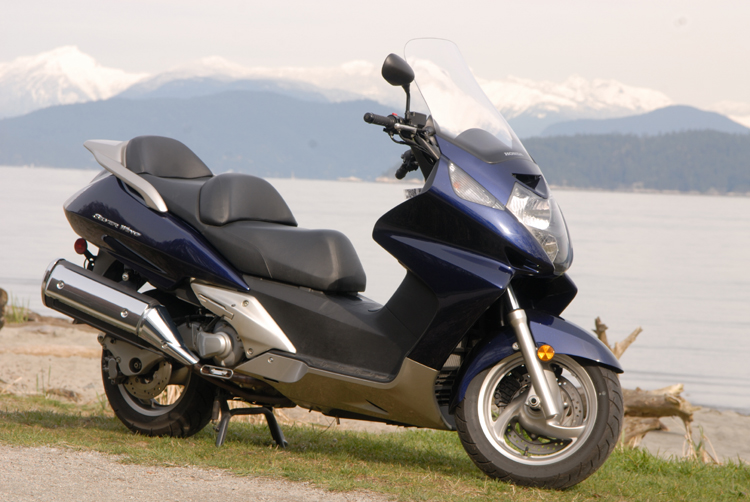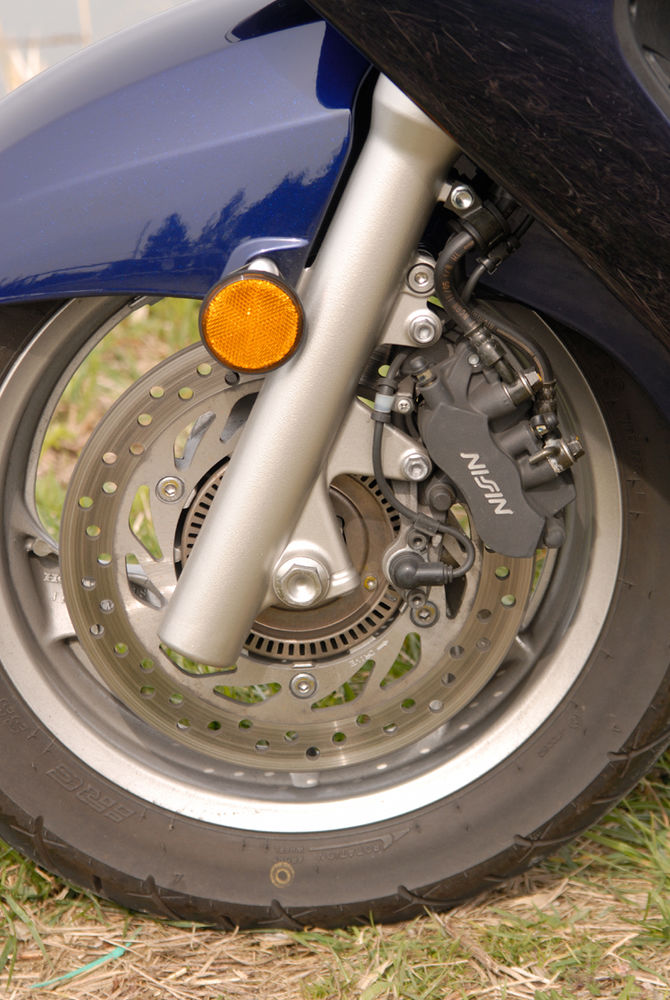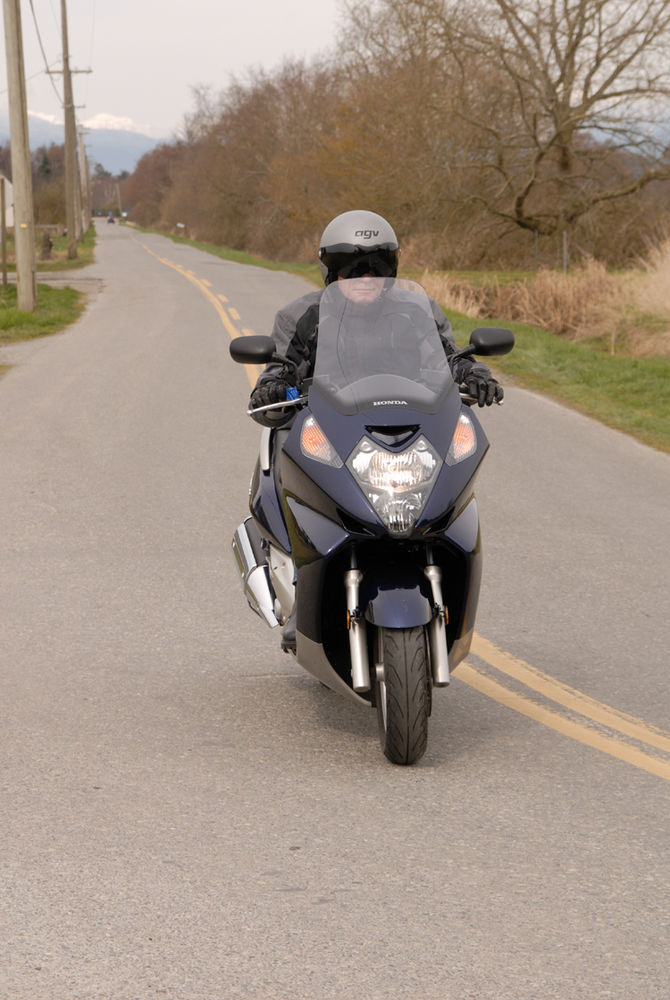2008 Honda FSC600A Silver Wing

As I rattled over the fir-plank bridge to Westham Island, a vast flock of snow geese swept overhead, darkening the sky and filling the air with surround-sound honking. In the filtered sunlight, their feathers took on a lustrous gray color, almost silvered. Silver Wing. What a great name for a scooter, I thought.
Big scooters are nothing new, of course. The Suzuki Burgman 650 is now five years old, the 400cc Yamaha Majesty is at least three (in North America) and Honda's 600cc Silver Wing has been on the books since 2002. RoadRUNNER has also presented test results for the Piaggio BV 500 and X9, Aprilia Atlantic, and the Kymco 500 Exciting in previous issues. But as the FSC600A is the machine that set the standard for big scooters, we thought it was time for a fresh take on the small-wheel Wing.
Scootability
I cut my riding teeth on scooters. My first "motorcycle" was a sporty Moto Rumi Formichino (and if you've never seen one, Google it), which I thrashed mercilessly, just as a 16-year-old should. Next, hoping to impress the ladies, I owned a Vespa 150cc Sportique. This model, produced under license in Bristol, England, by the Douglas Motorcycle people, featured a rotary valve engine tuned for economy, which really meant that most of the time it was quicker to walk.
Riding a scooter in England in the 1960s made a statement about your preferences and affiliations. My adolescent world was divided into Rockers (those leather-clad, oil-stained "oiks" who rode Bonnevilles and Gold Stars and listened to Gene Vincent) and Mods, who preferred button-down Oxford shirts, mohair suits, Lambrettas, and The Who. Sparks flew, often literally, whenever members of these two cultures found themselves within similar space-time coordinates - as the notorious riots that ruined many British holidaymakers' seaside weekends attest.

Fortunately, the animosity betwixt the spiritual inheritors of the Rocker creed ("outlaw" motorcycle types and their acolytes) and 21st-century scooterists extends mostly no further than curtailment of a biker wave. Though lacking in biker-bar street cred, scooters are no longer a personal liability.
In the intervening 40-ish years since I sold my Vespa, I've hoisted a leg over just about every type of two-wheeler, but my small-wheel experience has been limited to under-200cc machines. So I was keen to check out a scooter that, on paper, produced more power than the first four motorcycles I owned put together!
Safe and Sound
Weighing 551 pounds at curbside, the Wing is hardly svelte - though most of the weight is low down, so it's really only noticeable in garage maneuvering or when hoisting it onto its substantial center stand. (Unlike some scooters, there's also a kickstand.)
The open-frame design allows easy mounting, and the seat is large and squishy. The challenge with scooter seats is making them long and wide enough to provide proper thigh support, and at an angle that prevents the rider sliding forward. The Honda's seat felt pretty good once I'd squirmed my butt into a comfortable position, and the foot-forward riding position takes some acclimatization - especially if you've just gotten off a sportbike.

Starting the Wing is a breeze with the automatic cold-start enricher and PGM-FI engine management system, although you do have to activate at least one of the brakes to spin the starter. If there's no instant puttering from the exhaust, check to make sure you haven't got the kickstand down, too.
On the subject of brakes, the Honda is perhaps the best endowed on the market. Hauling on the left-hand lever (there is no footbrake) operates the twin-piston rear caliper and one of the three front pistons. The right lever connects to the front brake's other two pistons. In practice, it works seamlessly, bringing the big bike to a quick stop. The optional ABS also means it matters not a jot how hard you haul on the handles, the Wing will always come to a smooth-ish halt. "Smooth" in that it won't skid; "-ish" in that the ABS makes itself known when engaged with a staccato rattling.

In testing, I performed a quick stop or two, at least once hard enough for the ABS to cut in. If I hadn't heard it, I wouldn't have known it was working. It's the best ABS system I've tested so far.
And why is ABS important on a scooter? The smaller wheels on a scooter mean two things: a smaller tire contact patch and reduced un-sprung weight. (Also perhaps, there is the consideration that newer scooter owners may not be as well versed in braking technique as the general motorcycling population is.)
Reduced contact patch, in most situations, produces less traction between the tire and the road; so control over braking pressure is more critical. Lower un-sprung weight is usually a good thing, but in some circumstances - softer, under-damped suspension for example - it can exacerbate a tendency for the wheels to hop rapidly, which could compromise traction.
On the Silver Wing and most other ABS systems, a computer senses when the braking wheel has stopped turning, indicating that traction has been broken. The computer momentarily interrupts hydraulic pressure, releasing the brake to allow the wheel to pick up traction again, and repeating this process when traction breaks off again. It all happens many times a second, and the bottom line is - it works!
Another braking issue for big scooters concerns parking on hills. The V-matic belt drive in the Silver Wing is disengaged when the scooter is at a standstill with the engine turned off, so it's free to roll. Honda has thoughtfully included a parking brake, operated by a lever in the fairing panel.

So Much for Stopping: How Does it Go?
Suffice it to say that I embarrassed a number of performance cars on the Traffic Signal Drag Strip. While Honda claims just 50hp to pull the 550-plus-pound beast along, the V-matic transmission keeps the engine close to its peak torque revs while accelerating, so that maximum grunt is transferred to the tarmac. It's like traction control combined with a steam catapult. I'd bet on the Wing against a sportbike up to about 40mph, just because the motor is always "on the cam" with no clutch to slip to keep the revs up.
It keeps pulling strongly, too. I found a quiet back road and pinned the throttle. The speedometer went through 150kmh (about 95mph) pretty quickly and was still climbing when I shut off.
So it goes and stops. Now what about the characteristic scooters are often criticized for: handling?
Two features of a scooter militate against good handling. First, the smaller wheels have less gyroscopic effect, meaning it's typically easier to initiate a turn, but the scooter is less stable while turning; and second, there's nothing there for the pilot's knees to grip, meaning that body-weight distribution while turning is much less important. All told, that means scooters often feel more nimble because of their quick turn-in, but they lack the directional stability of a regular motorcycle when leaned over.
Some scooters work better than others in this respect. My 1961 Vespa was fitted with solid 8" diameter wheels, while the sportier mounts of the day, like the Lambretta GT or Vespa GS used 10" wheels. The wheels were interchangeable, so you could carry a spare wheel for a rapid curbside swap in the (then more frequent) event of a puncture.
Technology has moved on: punctures are rare considerations, and aerosol cans of quick-sealing sludge can fix a flat in seconds. That has allowed scooter manufacturers to ditch the spare wheel idea and choose different wheel sizes to better suit handling requirements. The Silver Wing has a 13" rear wheel and 14" front - still small by motorcycle standards, but imparting much better gyroscopic effect. Therefore the Wing is wobble-free in most cornering situations and feels much more planted on the road. Larger diameter wheels also deal with road imperfections and expansion joints better, all of which generates a superior ride.

The handling of the Silver Wing is something of a revelation. On my favorite highway cloverleaf, I threw it into the turn the way I would a sport-touring bike, and the Honda answered by sticking to my chosen line while responding eagerly to counter-steering inputs and eschewing any skittishness. All very confidence-inspiring.
Oh, and about the wave thing. Many motorcyclists won't wave to a scooter rider - after all, you don't need a motorcycle license for a 50cc scooter in most states. At any rate, expressions indicating our communal experience are still somewhat reserved among the two camps. No problem there with the Wing, though. Its sport-bike headlights and considerable road presence drew waves from sport bikers and cruiser riders alike - and I even collected a couple of high-fives!
How About a Tour?
Big scooters seem ideally suited to touring with their easygoing road manners, highway-hauling speed and passenger comforts. But how does the Wing stack up against a regular motorcycle?
For a weekend trip for two, you could probably get away with the under-seat luggage space - large enough for two full-face helmets or two small overnight bags. Beyond that, you'll need some extra luggage capability. Honda offers an accessory rack and 46-liter top box (as does Givi) to suit the Silver Wing, and that should take care of a long weekend or a short week. Accessory heated grips, wind deflectors, a taller windshield and passenger back- and armrests are also available. So for short trips, the Wing scores well, but could suffer from luggage inadequacies on long-distance tours. Throw-over panniers won't work easily.
Touring on a motorcycle can sometimes be more about the bike than the ride. That's fine for us gearheads, but I believe many more people would take to two-wheeled touring if the bike was as capable and easy to ride as the Silver Wing. I'd have no hesitation about loading up the Silver Wing for a few days of cruising. Its breezy deportment on the road, ample power, and twist 'n' go ease are all made for smelling the roses along the way. It's not a Gold Wing, of course, but then again you could have three Silver Wings for the same money. His, hers and a spare, perhaps?
Technical Specs
+ Lively performance, excellent brakes.
- Limited luggage capability, weight.
Distributor American Honda Motor Co. Inc.
Warranty one year unlimited mileage
MSRP $ 8,599.00
Engine four-stroke parallel-twin, DOHC, 8 valve
Displacement 582cc
Bore x Stroke 72mm x 71.5mm
Compression Ration10.2:1
Fuel System PGM-FI with automatic enricher circuit, four-hole injectors
Power 50hp
Cooling liquid
Ignition computer-controlled fully transistorized with electronic advance
Transmission automatic V-Matic belt drive
Suspension front: 41mm hydraulic fork; 4.7in (120mm) travel; rear: swingarm with dual hydraulic shocks, adjustable preload, 4.5in (114mm) travel
Brakes front: single 276mm disc with CBS three-piston caliper; rear: single 240mm disc with
CBS twin-piston caliper
Tires front: 120/80-14 rear: 150/70-13
Wheelbase 62.8in (1595mm)
Seat Height 29.7in (754mm)
Fuel Capacity 4.2gal (16l)
Colors metallic gray
Dry Weight 511lbs (232kg)